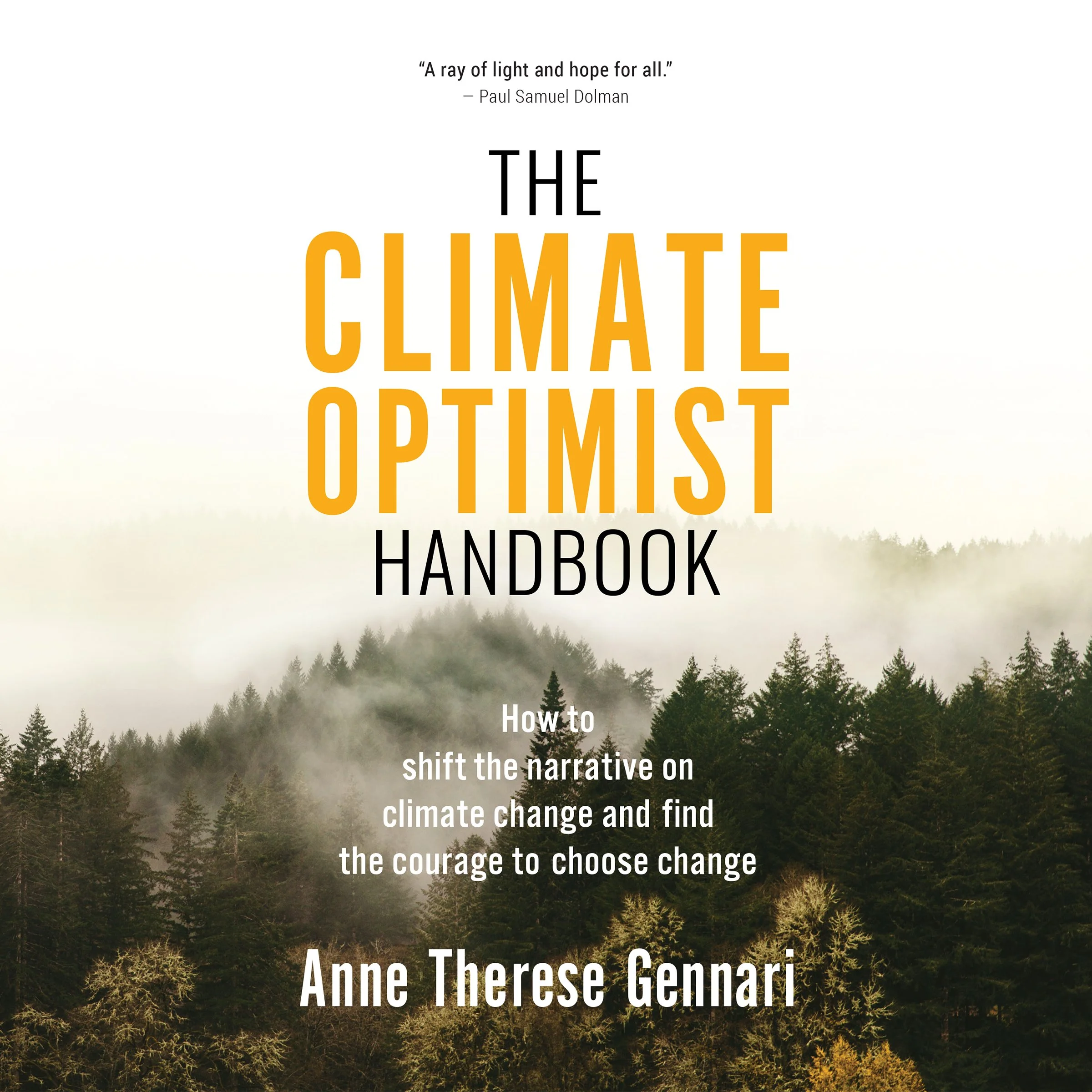What Is The Climate Optimist Handbook?
What if our approach to climate change could inspire hope and action rather than fear and paralysis? In The Climate Optimist Handbook, Anne Therese Gennari offers a refreshing perspective that empowers readers to embrace positive change in the face of environmental challenges.
(Originally written in a book review at Elevate Society)
Thank Elevate Society, for this beautiful write-up of my book! I wrote it as a call to step into radical hope. I wanted to help people find their inner light and choose to lead with empowered joy, and to see themselves as active creators of a better world.
Dive into the full review below and discover how you, too, can become a climate optimist. Let’s rewrite the narrative—together!
*Have you read the book and experienced different or similar insights? I would love to hear from you. Please connect with me here.
What is the Book About?
The Climate Optimist Handbook serves as a guide for individuals seeking to transform their climate anxiety into proactive optimism. Anne Therese Gennari emphasizes the importance of shifting the prevailing narrative around climate change—from one dominated by fear and guilt to one that highlights opportunity and hope. She argues that by adopting a mindset rooted in optimism, individuals can find the courage to engage in meaningful actions that contribute to a sustainable future.
Throughout the book, Gennari provides practical tools and insights designed to help readers navigate their emotional responses to climate change. She delves into the psychological barriers that often hinder action, offering strategies to overcome them. By fostering a sense of empowerment and resilience, the book encourages readers to view themselves as active participants in creating a better world, rather than passive observers overwhelmed by the magnitude of the crisis.
Book Details
Print length: 382 pages
Language: English
Publication date: October 21, 2022
Genre: Nonfiction
Book Author
Anne Therese Gennari is a TEDx speaker, educator, and advocate known as "The Climate Optimist." With over a decade of experience promoting climate optimism, she has collaborated with institutions such as Columbia University, BMW, and the United Nations Global Compact. Gennari's mission is to shift the climate change narrative from fear to empowerment, helping individuals and organizations embrace sustainable practices with enthusiasm and hope.
Core Theme
At its heart, The Climate Optimist Handbook champions the idea that optimism is a powerful catalyst for change. Gennari asserts that while the realities of climate change are daunting, adopting a hopeful outlook enables individuals to take meaningful action without being paralyzed by fear. This shift in perspective transforms the climate crisis from an insurmountable problem into an opportunity for innovation and growth.
The book also explores the psychological aspects of climate action, addressing common feelings of guilt and helplessness. Gennari provides readers with strategies to reframe these emotions, encouraging a proactive stance that focuses on solutions and personal empowerment. By fostering a mindset of optimism, she believes individuals can contribute more effectively to collective efforts aimed at addressing environmental challenges.
Main Lessons
A few impactful summary lessons from The Climate Optimist Handbook:
1. See Climate Change as a Human Challenge
Climate change is not just an environmental, political, or economic issue—it is fundamentally a human challenge. The book emphasizes that we, as humans, are both the root cause and the potential solution to the climate crisis. Instead of seeing climate change as an external problem, we should recognize it as a collective human endeavor, one that requires us to confront our habits, beliefs, and perceptions.
The key is to realize that while we have caused significant damage to the planet, we also possess the ingenuity and capability to repair it. Shifting the narrative from blame to responsibility allows us to reclaim our power and embrace the opportunity to create a sustainable future.
2. Shift Your Perspective to Climate Optimism
Being overwhelmed by climate data and dire predictions often leads to paralysis rather than action. The Climate Optimist Handbook suggests flipping this mindset by embracing climate optimism—a belief that positive change is not only possible but inevitable if we choose to act.
Optimism in the climate context does not mean ignoring the severity of the problem but rather acknowledging that human innovation and determination can drive solutions. This perspective inspires courage and propels individuals to take small, consistent actions toward environmental sustainability, thus transforming despair into purposeful engagement.
3. Focus on Maximizing Positive Impact
Instead of obsessing over minimizing your carbon footprint, the book encourages focusing on maximizing your positive impact. Guilt and self-blame do not contribute to progress; they often inhibit it. By reframing our approach from reducing harm to creating good, we can channel our efforts more productively.
Whether it’s through supporting renewable energy, engaging in community initiatives, or making mindful consumer choices, the goal is to add value to the planet rather than merely reducing the damage. This proactive stance makes sustainability a rewarding adventure rather than a burdensome duty.
4. Practice Retruthing to Challenge Preconceived Notions
Retruthing is the practice of questioning long-held beliefs and perceptions about climate change and societal norms. The book argues that many of our assumptions about environmental issues are outdated or skewed by fear. To create meaningful change, we must be willing to unlearn and relearn, embracing new perspectives that foster resilience and adaptability.
Retruthing is about moving past denial and fear, allowing space for a more nuanced and hopeful understanding of our role in the global climate narrative.
5. Embrace the Power of One Step at a Time
Climate action can feel overwhelming when seen as an all-or-nothing endeavor. However, the book highlights the importance of taking one impactful step at a time. Whether it’s adopting a plant-based meal a few times a week, reducing single-use plastics, or simply sharing climate knowledge with friends, every small action counts. By breaking down the journey into manageable parts, individuals can avoid burnout and sustain long-term commitment to positive environmental change. This approach fosters a sense of accomplishment rather than guilt, motivating continued effort.
6. Choose Empowerment Over Guilt
Blame and guilt are counterproductive when addressing climate change. The Climate Optimist Handbook argues that it’s more beneficial to focus on empowerment—cultivating a mindset where actions, no matter how small, are seen as meaningful. Instead of shaming others or ourselves, we should celebrate progress and share stories of positive change.
The book encourages finding community and solidarity, where collective actions are amplified, and personal contributions are valued. This collective empowerment shifts the narrative from solitary struggle to communal hope.
7. View Climate Action as an Adventure
Reframing climate action as an adventure rather than a chore is a powerful mindset shift. The author explains that adopting sustainable practices should feel like exploring new possibilities, not like carrying a burden.
This adventurous spirit keeps motivation high and encourages creativity in finding solutions. Whether it’s discovering innovative ways to reduce waste or learning to grow your own food, making sustainable choices becomes a journey of discovery rather than a tiresome obligation.
8. Accept That Climate Solutions Are Imperfect
One major barrier to taking climate action is the fear of not doing enough or not being perfect. The book stresses that perfectionism can be paralyzing and that real progress comes from imperfect but genuine efforts.
Embracing the idea that it’s okay to make mistakes or take gradual steps reduces anxiety and fosters a more positive attitude towards environmental responsibility. The goal is not to achieve flawless sustainability but to be consistently willing to improve.
9. Encourage Others by Leading with Joy
Often, climate activism is portrayed as stern and guilt-driven, which can alienate rather than inspire. The book advocates leading with joy, showing that living sustainably is not about sacrifice but about enhancing one’s quality of life. Sharing positive stories, expressing excitement about eco-friendly innovations, and celebrating collective victories make the movement more inviting.
By leading with joy rather than anger or blame, you naturally draw people in, making climate action a communal and uplifting experience.
10. Stay Curious and Open to Learning
The climate conversation is ever-evolving, and staying informed requires an open, curious mindset. The book encourages readers to continuously seek new information, question assumptions, and explore innovative solutions.
Being adaptable and curious not only enriches one’s understanding but also cultivates a resilient mindset capable of navigating environmental challenges. The journey towards sustainability is not about reaching a fixed point but about continuously evolving and growing.
Key Takeaways
Key summary takeaways from the book:
Shifting from fear to optimism can empower individuals to take meaningful climate action.
Understanding psychological barriers helps overcome feelings of guilt and helplessness.
Practical tools and strategies can transform climate anxiety into proactive engagement.
Viewing the climate crisis as an opportunity fosters innovation and positive change.
Individual actions, when rooted in optimism, contribute significantly to collective environmental efforts.
Book Strengths
The Climate Optimist Handbook excels in its ability to blend personal anecdotes with actionable advice, making complex psychological concepts accessible to a broad audience. Gennari's approachable writing style and emphasis on optimism provide a refreshing contrast to the often doom-laden discourse surrounding climate change. The inclusion of practical tools ensures that readers are not only inspired but also equipped to take tangible steps toward sustainability.
Who This Book Is For
This book is ideal for individuals who experience climate anxiety and seek a constructive path forward. It's also well-suited for educators, activists, and leaders looking to inspire others with a hopeful and action-oriented approach to environmental challenges. Anyone interested in transforming their concern for the planet into empowered action will find valuable insights within these pages.
Why Should You Read This Book?
Reading The Climate Optimist Handbook offers a transformative perspective on addressing climate change. Gennari's emphasis on optimism and practical action provides readers with the tools to overcome paralysis and engage meaningfully with environmental issues. The book serves as both a source of inspiration and a guide for those ready to contribute to a sustainable future with confidence and hope.
Concluding Thoughts
In a time when climate discourse is often dominated by fear and despair, The Climate Optimist Handbook stands out as a beacon of hope. Anne Therese Gennari's insights encourage readers to reframe their mindset, viewing environmental challenges as opportunities for growth and positive change. By combining psychological understanding with actionable strategies, the book empowers individuals to become proactive participants in the movement toward sustainability.
Embracing optimism in the face of climate change is not about ignoring the realities but about finding the courage to act despite them. The Climate Optimist Handbook equips readers with the mindset and tools necessary to make a meaningful impact, fostering a sense of agency and hope in the collective journey toward a better world.
* The publisher and editor of this summary review made every effort to maintain information accuracy, including any published quotes, lessons, takeaways, or summary notes. Originally shared on Elevate Society.



